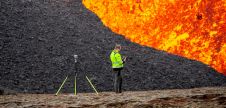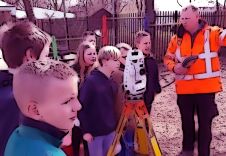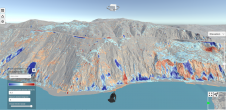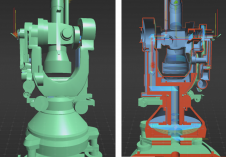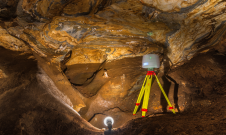移位的专业映射世界
188金宝搏特邀GIM国际访谈Christoph Strecha,PIX4D的首席执行官和创始人
PIX4D的Christoph Strecha,创始人兼首席执行官,揭示了他在这次采访中预见地理空间行业的大变化,“Gim International”。188金宝搏特邀
Over the past decade, photogrammetry from unmanned aerial vehicle (UAV or ‘drone’) data has proven itself as an effective method to capture high-resolution aerial imagery, while drones have demonstrated their value for mapping and surveying professionals as platforms for carrying payloads that include a variety of sensors. One of the leading developers of software solutions to convert the imagery into high-end geospatial solutions is Pix4D, which has established itself as a leader in the business. Christoph Strecha, founder and CEO, talked to '188金宝搏特邀Gim International'和revealed that he foresees big changes in the geospatial industry.
Your company was started in 2011 as a spin-off of the prestigious École Polytechnique Fédérale de Lausanne (EPFL) in Switzerland. How would you describe your company’s journey since then?
我们开始基于产品的结果of ten years of research. I think that we were one of the first to say that you could do automatic结构体-从运动摄影测量。鉴于无人驾驶和发展的炒作,这是将产品带到市场的完美时间。从那时起,我们继续增长,继续获得良好的反馈并产生高水平的兴趣。我们每年都会将我们的团队翻倍,我相信我们已经为职业竞技场中的无人机映射做出了很大贡献。
How would you describe the state of the geospatial industry at the moment?
曾经有一段时间,地理空间行业被专家占主导地位。他们使用了非常昂贵的高级设备来创建地图和调查刚刚达到较小公司和社区的大面积。188asia备用网址这已经开始在过去三年中转移,这是一个正在进行的过程。现在,地理空间行业的调查设备可以由那些拥有更少经验的人使用 - 他们可以基本上使用技术作为解决问题的工具。这在行业新部门开辟了很多机会,因为随着价格下跌,事情变得更加容易,变得更加自动化。我认为发生了很大的变化。虽然我们喜欢认为我们在中断行业的作用时,这种变化不仅仅是即将到来的PIX4D,而且来自大型测量公司,因为他们的设备越来越便宜并被更广泛的公众使用。188asia备用网址

You started to verticalise your products a couple of years ago. Which emerging markets is Pix4D focusing on today?
今天我们专注于企业解决方案。我认为越来越大的公司热衷于在他们的工作流中使用摄影测量,188asia备用网址因为他们已经看到这种方法是实际拯救他们的钱。我们专注于更大的客户,这意味着我们与复杂的工作流程整合的定制解决方案。另一个重点是农业,无人机在作物分析方面可以是一个很大的帮助。对于农民和农学学家来说,我们正在建立易于使用的解决方案,并将节省金钱。例如,我们最近从柏林办事处推出了PIX4DFIELDS。最后,我们专注于建筑,调查已经是普遍的做法,但也非常昂贵,因此没有定期完成。因此,随着无人机和3D建模,我们可以帮助建筑公司了解其建筑工地的进度,优化工作流程并在计划中使用这些信息。188asia备用网址即使他们不能定期飞行无人机,就像在许多情况下的情况一样,我们的起重机相机解决方案可以提供具有相同结果的空中图像。
如你所提到的,垂直是过去几年我们一直在关注的东西。垂直的增长是无人机市场整体种植的证据,因为现在需要每个行业的专业软件。
鉴于无人机的摄影测量软件解决方案的越来越多,在购买前应考虑到的主要点测量师是什么?
正如我之前所说的那样,我相信最终用户将更频繁地使用这些工具,因此易用性和良好的支持比以往更重要。使用无人机的测量公司数量也有所增加,但最终用户之间的增长相当高。188asia备用网址
测量师将有大量的无人机可供选择,修复翼或转台,他们应该知道哪一个用于优化他们的测量工作。在无人机上RTK还可以节省您必须衡量额外的GCPS(地面控制点,ED。例如,So测量师应选择配备RTK的无人机。这是巨大的效率。这些日子很容易找到解决方案,但有很多事情要考虑。测量师不仅仅是软件,还要看看它的解决方案。如果出现问题,那么的支持是什么?是否在同一领域中的其他软件用于获得最佳结果?如果需要,最终用户可以选择并与软件一起工作吗?最后,软件是否来自一家已成熟的公司,因此验船师可以预期未来几年的更新和支持?
越来越关注无人机的有效载荷。你预见到哪个关键趋势?
我认为我们可以期望看到更优化的有效载荷,具有更好的相机,提供更好的分辨率,钻机系统和组合的透视相机系统,可以提高效率。然后我们具有多光谱传感器的趋势,与热传感器和RGB相结合。关于激光雷达还有很多炒作,但它仍然是市场的利基部分。它减少了无人机的飞行时间,但它也大大提高了设备的价格和工作流程的复杂性,因此它没有与摄影测量相同的优势。我不确定这项技术将成为测量师和最终用户的工作流程中的主流,因为钻机系统和组合的相机将在未来几年内成为主流。
PIX4D以其与EPFL计算机视觉实验室合作的研发努力而闻名。这仍然是贵公司的重要支柱吗?
作为一个技术公司,在PIX4D,我们在很大程度上投入了技术,以改善我们的算法,我们与EPFL和许多其他大学合作。但我们也推动了很多内部进行研究,以了解我们如何为用户增加更多价值,因此我们已经建立了更大的研发努力来为客户提供服务。

Artificial intelligence (AI) and machine learning are likely to play an essential role in the future of drone mapping. Is Pix4D ready for the future in this sense?
I don’t think anybody is really ready today, but we are investing considerably in that direction and I’m hoping we can do much more in this area. We are very focused on increasing the AI capabilities of our algorithms in combination with the photogrammetry that Pix4D already handles very well. Regarding AI, we presented a desktop product at last year’s Intergeo that uses machine learning to automatically classify point clouds into different classes. I believe we were the first company in this field to present the use of AI in that way. This is a very important topic that we will continue to explore, because actually it’s not the 3D model itself that matters, but rather the automatically extracted information that creates much more value than the 3D data.
Drones are becoming cheaper all the time, so is this increasing the number of potential customers?
Definitely. As drones become cheaper they become a standard tool for end users in their workflow. We are also focusing on making the software easier to use, so it can be used by more people. We believe that the combination of easy and dedicated verticalised software with cheaper drones is key to market growth.
You once said “A drone should be seen as a device”. So, turning our attention to another device, what are the latest developments with respect to Pix4D’s Crane Camera solution?
A drone is a very handy way to get a camera in the air and to acquire images from positions that are needed in order to build 3D models from interesting viewpoints. But flying one can still be somewhat disruptive to a workflow, and of course it requires a pilot. At Pix4D we think it’s not the drone that is most important, but rather the position of the sensor while acquiring images. The Crane Camera is a very nice illustration of that. The crane moves, taking images from different viewpoints, which is what the technology requires. It’s a trend we’re seeing more and more of: more cameras being used – both moving such as in cars and trains, and static such as in cities, stadiums, airports and so on – to extract information from reality. This is the core of Pix4D’s business. It might not be the most important thing, but today a drone is a near-perfect tool to obtain the viewpoints needed to extract the information.
建筑信息建模(BIM)被视为测量师的兴趣机会。你对此有什么看法?
This goes together with converting raw images, not only into point clouds or meshes but also into information. A mesh doesn’t have much more value than the original images. Automatically understanding what this mesh represents – what is a simple structure, what are semantic structures – that’s where the value lies, because it means there’s no human operator needed to extract the semantic information from the 3D model. BIM is a good example of how this concept of converting images to information can be applied and is extremely useful.
Which next steps can we expect to see on the processing side?
正如我提到的,机器学习将是一个巨大的change for the industry. Companies will put a lot of effort into analysing the data in a semantic way: not just presenting images, but really extracting information from them. The standard processing workflows are working really well, although there’s always the need to process faster – it’s important to keep updating that, which is a focus for us. But that won’t be a revolutionary change, at least in the short term. What we can expect is to apply photogrammetry, machine learning, geometry and radiometry from images in particular industries. That’s where we’ll see most of the developments in image processing in the future.
最后,您对映射和测量专业人士社区的信息会是什么?
I think it’s very important that everyone who works professionally with UAVs embraces public opinion positions on privacy and security issues regarding flying with drones. All the companies in the sector, whether they are software companies, hardware companies or surveyors that use drones in their work, need to work together towards a clear public definition of drones as an essential professional tool – one that can be fundamental in emergency response situations like earthquakes, for example. Drones have many useful professional applications that have nothing to do with spying on your neighbours, flying for fun or military applications. The general public needs to be made aware of the pros and cons of drone usage so that legislation is put in place correctly, in order to allow drones to be used where they add value to our society.
关于Christoph Strecha.
Dr Christoph Strecha is the CEO and founder of Pix4D, a Swiss company which develops and markets professional photogrammetry software. Dr Strecha received a PhD from the Catholic University of Leuven (Belgium) in 2008, completing his thesis on multi-view stereo. He has authored numerous papers and in 2015 received the Carl Pulfrich Award for his work in computer vision and photogrammetry. He is recognised by the scientific community as an influencer, trendsetter and advocate of modern approaches to photogrammetry.






